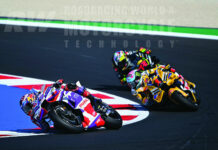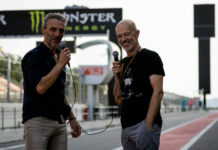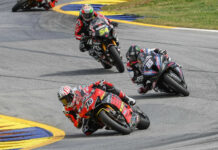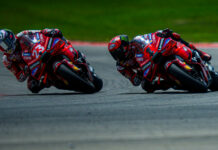From a press release issued by AMA Pro Racing:
2003 AMA Superbike rules now set, period of public comment results in modifications
The 2003 AMA Chevy Trucks U.S. Superbike Championship will mark an exciting period of transition for America’s premier motorcycle road-racing series. Beginning next March in the season kickoff at Daytona International Speedway, 1000cc multi-cylinder Superbikes will race side-by-side with 1000cc twins and 750cc-based multi-cylinder machines.
AMA Pro Racing first proposed this new formula in June to reflect the changing motorcycle marketplace and provide opportunity for more teams to compete in the series. A public comment period resulted in one major change to the proposed rules. Traditional 750cc four-cylinder machines now will be allowed 2 millimeters of cylinder overbore for a displacement close to 800cc in an effort to keep existing 750 Superbikes competitive in the period of transition to the new specifications.
“It’s always tough to find the proper balance when implementing a new racing formula, especially in a series that means so much to so many,” said Scott Hollingsworth, AMA Pro Racing CEO. “Our technical staff came very close to hitting the mark in the original proposal, and after the public comment period I’m confident that we’ve struck a good balance that allows a wide variety of racing machinery to be on equal footing.”
“We are trying to put the best racing product on the track for the benefit of fans and teams,” said Merrill Vanderslice, AMA Pro Racing director of competition. “Our goal is to have close competition in 2003, and we will consider minor adjustments to the rules as needed to balance competition.”
Vanderslice added that the rules package also addresses the changing market, as many new motorcycles are expected to be eligible for competition in 2004 under this AMA Superbike formula.
In an effort to establish a global technical specification for Superbike racing, AMA Pro Racing met with other national governing bodies and the technical arm of the FIM. Although a consensus could not be reached at this time, AMA Pro Racing remains hopeful that a single specification can be achieved in the future.
2003 AMA U.S. Superbike Championship rules
Only approved motorcycles are permitted in AMA Superbike competition. AMA Pro Racing will accept homologation applications only from motorcycle manufacturers or their distributors.
1. Allowable engine displacements and basic homologation requirements:
A. 551cc – 750cc four-stroke, four cylinders:
Engines with displacements originally within this range may have cylinder bore increased by a maximum of 2mm, with the resulting displacement not to exceed 800cc. Stroke must remain stock.
Homologation requirements will remain the same as current (2002) Superbike requirements, including street certification in an FIM member country and a minimum number of units imported into the US for sale.
B. 551cc – 900cc four-stroke, three cylinders:
551cc – 1000cc four-stroke, twin cylinders:
Homologation requirements will remain the same as current (2002) Superbike requirements.
C. 901cc – 1000cc four-stroke, three or more cylinders:
This is a new displacement category offered as an option beginning with the 2003 season.
Homologation requirements include street certification in the U.S. and a higher minimum number of imported units relative to current Superbike requirements.
2. Weight:
Minimum weight for all Superbikes will be increased to 370 pounds from the current 355 pounds.
3. Other major technical regulations:
Except for the items previously noted, 750cc four cylinders, 900cc three cylinders and 1000cc twin cylinders will be subject to all current (2002) Superbike technical regulations for the 2003 season.
1000cc equipment with three or more cylinders will be subject to the following major technical regulations:
A. Frames must be stock except for the addition of strengthening gussets and the removal or relocation of accessory brackets (same as current rules).
B. Aftermarket forks, shocks and swingarms will be permitted. Forks/shocks will be subject to claiming rules (same as current rules).
C. Aftermarket wheels (except carbon composite) will be permitted. Rear wheel maximum width is 6.25″ (same as current rules).
D. Aftermarket brakes (except carbon composite) will be permitted (same as current rules).
E. Aftermarket fairings and body work will be permitted (same as current rules).
F. Cylinder heads may be ported and machined, but altering of valve angles will not be permitted.
G. Aftermarket valves, springs, retainers and other valve-train components will be permitted. Valves must be stock size and same basic material as original equipment.
H. Aftermarket camshafts will be permitted, but cam lift and resulting valve lift must be no greater than stock.
I. Stock cylinders and cases must be retained. Machining will be permitted (same as current rules).
J. Aftermarket pistons, rings, pins and connecting rods will be permitted (same as current rules).
K. Stock crankshaft must be retained. The only allowable modifications are balancing, polishing of bearing surfaces and attachment of accessory drives.
L. Homologated transmission gear sets (one optional set of ratios per approved model) will be permitted. Optional sets will be price-controlled and must be available to any legitimate AMA Superbike competitor.
M. Aftermarket, stock-type (wet type cannot be changed to dry type) clutches with back-torque limiting characteristics will be permitted.
N. Homologated fuel-injection throttle-body assemblies (one optional type per approved model) and aftermarket air boxes will be permitted. Modifications to throttle bodies will not be permitted. Optional throttle bodies will be price-controlled and must be available to any legitimate AMA Superbike competitor.
O. Aftermarket ignition systems will be permitted (same as current rules).
P. Charging systems and starters will not be required (same as current rules).
Q. Aftermarket exhaust systems will be permitted (same as current rules).
AMA Pro Racing Releases 2003 Superbike Rules
AMA Pro Racing Releases 2003 Superbike Rules
© 2002, Roadracing World Publishing, Inc.






